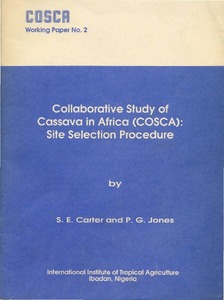| dc.contributor.author | Carter, S.E. |
| dc.contributor.author | Jones, P.G. |
| dc.date.accessioned | 2019-12-04T11:29:58Z |
| dc.date.available | 2019-12-04T11:29:58Z |
| dc.date.issued | 1989 |
| dc.identifier.citation | Carter, S.E. & Jones, P.G. (1989). Collaborative Study of Cassava in Africa (COSCA); site selection procedure: COSCA working paper, No. 2. Ibadan, Nigeria: IITA, (36p.). |
| dc.identifier.uri | https://hdl.handle.net/20.500.12478/5130 |
| dc.description.abstract | This paper describes the methods of site selection used for a village-level survey which comprised the first phase of the Collaborative Study of Cassava in Africa (COSCA). Potential survey regions are defined using spatial data which describe ecological conditions, human population densities, accessibility, and the distribution of cassava production. Sixteen different types of regions are identified. Methods are described for selecting random samples of grid cells in each survey region, and for identification of 'villages' for surveys within each cell. The grid used for mapping climate. population, access and the crop's distribution is maintained as a frame throughout the survey site selection process. This will be useful during data analysis jf raster techniques are employed to map the data generated. |
| dc.language.iso | en |
| dc.subject | Surveys |
| dc.subject | Households |
| dc.subject | Cassava |
| dc.subject | Data |
| dc.title | Collaborative Study of Cassava in Africa (COSCA); site selection procedure: COSCA working paper, No. 2 |
| dc.type | Working Paper |
| cg.contributor.affiliation | International Institute of Tropical Agriculture |
| cg.coverage.region | Africa |
| cg.coverage.region | West Africa |
| cg.coverage.country | Nigeria |
| cg.authorship.types | CGIAR single centre |
| cg.iitasubject | Soil Surveys And Mapping |
| cg.iitasubject | Livelihoods |
| cg.iitasubject | Cassava |
| cg.iitasubject | Research Method |
| cg.accessibilitystatus | Open Access |
| local.dspaceid | 102394 |

